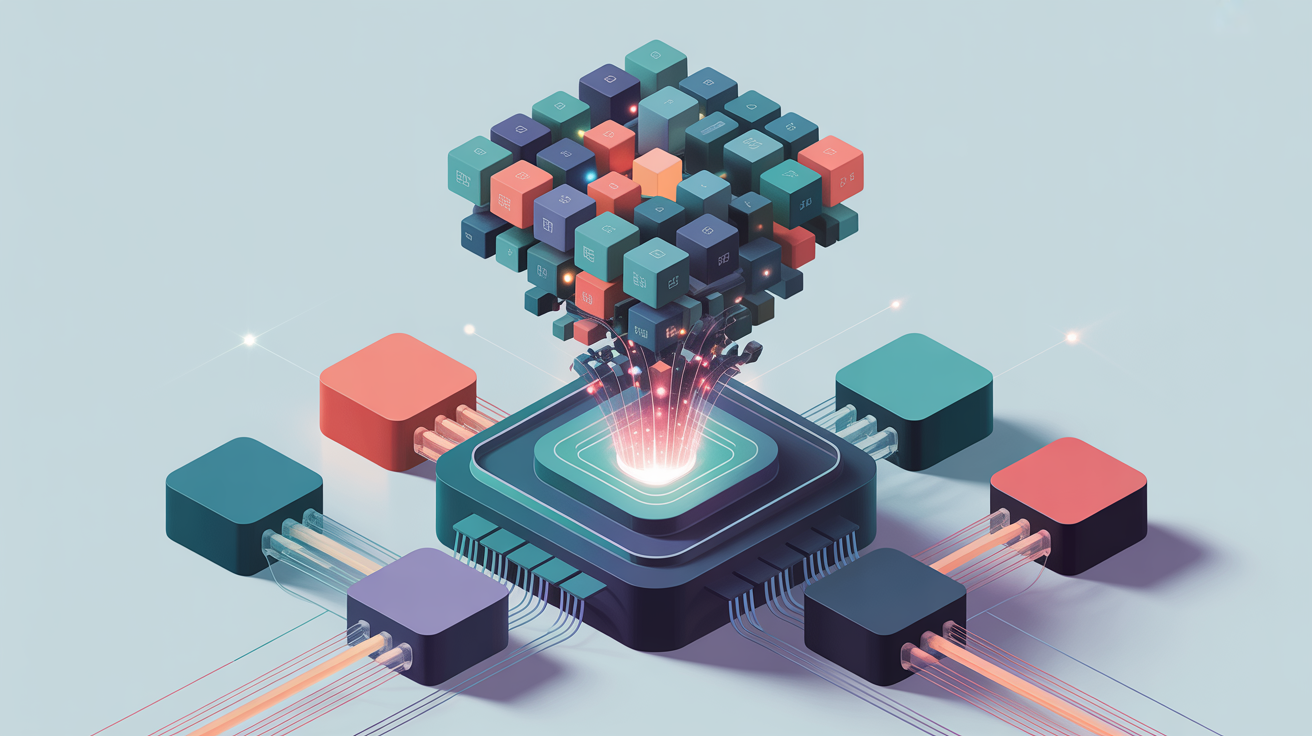What's The Framework for Advanced Context Retrieval in RAG Systems?
AI Systems • Nov 10, 2025 3:44:20 PM • Written by: Kelly Kranz

The fundamental framework involves retrieving relevant information and providing it as context to an LLM during the generation phase. However, the efficacy of a RAG system is critically dependent on the nature and granularity of the context it provides. The architectural decision of whether to supply a small, precise text chunk, a larger contextual block, or an entire source document is a complex trade-off with implications for system performance, cost, and accuracy.
RAG enables models to ground their responses in external, up-to-date, and proprietary knowledge sources. This article presents an architectural framework for navigating these choices, moving beyond a binary “chunk vs. document” view to a spectrum of retrieval strategies. By analyzing context window capabilities and retrieval patterns, we outline a blueprint for an adaptive RAG system that dynamically selects the optimal strategy based on query intent and data structure. Retrieval-Augmented Generation (RAG) is a cornerstone of modern LLM applications. The efficacy of any RAG system hinges on how much context you retrieve—and at what granularity.
Frequently Asked Questions
What is the RAG Context Spectrum?
The RAG Context Spectrum is a framework that maps retrieval strategies from granular, sentence-level context to full-document context. It helps architects choose how much context to supply an LLM based on query intent, document type, and system constraints.
What is the core trade-off between precision and context?
Smaller, precise chunks improve retrieval accuracy, efficiency, and cost, but can lose important surrounding information. Larger contexts add richer understanding for complex tasks but increase latency, cost, and the risk of irrelevant noise.
When should I use Granular Retrieval (Chunk-Only)?
Use chunk-only for specific factoid questions, cost- and latency-sensitive applications, and very large corpora where retrieving full documents is infeasible. It maximizes precision and efficiency but risks context fragmentation if chunking is naive.
When should I use Expanded Window Retrieval (Sentence-Window)?
Use sentence-window when local context around a retrieved fact matters—such as resolving pronouns, interpreting definitions, or understanding steps in procedures. It searches at sentence level and expands by a configurable window to restore nearby context.
What is Hierarchical Retrieval (Parent-Document / Small-to-Big)?
Hierarchical Retrieval indexes small child chunks for precise search and, upon retrieval, expands to larger parent chunks for generation. It balances precision and context, especially for structured documents like manuals or legal texts.
When is Full-Document Synthesis appropriate?
Use full-document synthesis for summarization, complex intra-document comparisons, and high-stakes domains where full context is necessary. It is the most expensive and is viable only when documents fit within the model’s effective context length.
What is the “Lost in the Middle” problem?
In long prompts, LLMs attend most to the beginning and end of the context and often underuse information placed in the middle. This U-shaped attention pattern makes indiscriminate prompt stuffing risky, even for long-context models.
What is effective context length and why does it matter?
Effective context length is the task-specific window size where a model performs best. Beyond this size, adding more text can degrade accuracy and increase cost. Designing RAG systems around the effective, not advertised, context length improves reliability.
How does an Adaptive RAG router work?
An Adaptive RAG router is a lightweight LLM-based classifier that infers query intent, optionally rewrites or expands the query, and then routes it to the optimal retrieval strategy. It can also trigger re-ranking and context re-ordering to improve final answer quality.
How should I evaluate and improve a RAG system?
Evaluate retrievers with Hit Rate and MRR, and generators with faithfulness, answer relevance, and context relevance. Use automated judges, collect user feedback, and iterate on chunking, embeddings, prompts, and routing to drive continuous improvement.
The Fundamental Trade-Off: Precision vs. Context
At the heart of RAG architecture lies a persistent tension between retrieval precision and generative context. Every design choice regarding data chunking and context delivery prioritizes one over the other.
Precision-Oriented Retrieval
Precision-oriented retrieval provides the LLM with small, semantically dense, and highly relevant text segments (“chunks”). When a document is broken into small units (e.g., 128–512 tokens), each embedding represents a more specific, atomic concept, reducing semantic noise.
Advantages include improved retrieval accuracy for fact-based queries, lower token usage (reducing cost and latency), and scalability for large knowledge bases. The drawback is potential loss of surrounding context: naive fixed-size splitting can sever sentences or ideas, producing fragments that lack antecedents, definitions, or preceding arguments—risking confusion or hallucinations.
Context-Oriented Retrieval
Context-oriented retrieval supplies larger segments—multi-paragraph sections or entire documents. This is essential for tasks like summarization, thematic analysis, complex comparisons, or high-stakes domains where partial context is risky.
Drawbacks include higher cost and latency, plus the risk of introducing irrelevant “noise” that can overwhelm attention and dilute key facts—leading to degraded answer quality.
Deconstructing the Modern LLM Context Window: Capabilities and Pathologies
The Promise of Long Context
Expanding context windows (e.g., 128k–2M tokens) suggest a simpler future: consolidate relevant data into one prompt and let the model recall what matters. For small corpora, you could even place the entire knowledge base in the prompt, bypassing RAG.
The Reality: “Lost in the Middle”
Empirical work shows a U-shaped performance curve: models favor information at the beginning and end (primacy/recency) and under-utilize details in the middle. Simply “stuffing the context” increases the chance the right info is present, but not that the model will attend to it.
Evidence: “Needle in a Haystack”
Benchmarks place a specific fact (“needle”) at varying depths inside large unrelated text (“haystack”). Models recall near the start or end but degrade as the needle approaches the center. With multiple needed facts, performance drops further.
Performance Variability & Effective Context Length
Performance varies by model and task. Many models peak at an effective context length (often far below the maximum). Beyond that point, adding more tokens can harm accuracy, inflate cost, and slow responses. In practice, RAG’s role evolves from bypassing memory limits to focusing attention—filtering, ordering, and prioritizing the most salient context.
A Taxonomy of Context Retrieval Strategies
A robust RAG system needs multiple retrieval modes and the flexibility to match strategy to the query and data. Below are four primary patterns—from granular to comprehensive.
Strategy 1: Granular Retrieval (Chunk-Only)
Mechanism: Pre-split documents into small, coherent chunks (e.g., 128–512 tokens). Embed and index each chunk. On query, retrieve top-k chunks and pass only those to the LLM.
When to Use: Factoid queries and simple Q&A; strict latency/cost budgets; very large knowledge bases.
Trade-offs: Risk of context fragmentation and ambiguity if splitting severs meaning.
Strategy 2: Expanded Window Retrieval (Sentence-Window)
Mechanism: Embed at the sentence level. Retrieve the best-matching sentence, then programmatically add surrounding sentences (e.g., ±2) to restore local context.
When to Use: Queries needing local continuity (pronouns, definitions, steps).
Trade-offs: May still miss broader, document-level context; window size needs tuning.
Strategy 3: Hierarchical Retrieval (Parent-Document / Small-to-Big)
Mechanism: Split into larger “parent” chunks and smaller “child” chunks. Index children; store parents in a docstore. Retrieve children, then expand to parents for generation.
When to Use: Balance precision and context; structured documents (manuals, contracts, books).
Trade-offs: More complex (dual stores) and can reintroduce large-context costs and risks.
Strategy 4: Full-Document Synthesis
Mechanism: Use retrieval to identify sources, then pass entire documents to the LLM.
When to Use: Summaries, thematic analysis, intra-document comparisons, and high-stakes domains.
Trade-offs: Most expensive and slowest; vulnerable to “Lost in the Middle”; must respect effective context limits.
The strategies form a continuum of granularity. An advanced system should dynamically select among Single Sentence → Sentence Window → Small Chunk → Parent Chunk → Full Document at runtime.
The Architect’s Decision Matrix: Selecting the Optimal Strategy
Factor 1: Query Intent Analysis
- Synthesis/Factoid: Direct, self-contained facts.
- Summarization: Condensed overviews.
- Comparison: Intra- or inter-document contrast.
- Exploratory/Reasoning: Open-ended synthesis and reasoning.
Factor 2: Document Archetype Analysis
- Dense, Unstructured Prose: Long-form articles, blogs, news.
- Highly Structured/Hierarchical: Manuals, legal, financial reports, academic papers.
- Atomic/Fragmented: FAQs, Q&A pairs, chat logs.
- Data-Heavy/Non-Prose: Tables, code, logs (domain-specific parsing).
Factor 3: System Constraint Analysis
- Latency Budget
- Cost Budget
- Accuracy Threshold
- Explainability Requirements
Context Strategy Selection Matrix
| Query Intent | Dense Prose (e.g., Blog) | Highly Structured (e.g., Manual) | Atomic (e.g., FAQ) | Data-Heavy (e.g., Financial) |
|---|---|---|---|---|
| Factoid / Synthesis | Sentence-Window or Granular | Granular (respect structure) | Granular | Domain-specific chunking (e.g., row) |
| Summarization | Full-Doc or Parent-Chunk (large) | Parent-Chunk (section summary) | N/A (summarize retrieved chunks) | Multi-chunk synthesis or Full-Doc |
| Comparison (Intra-doc) | Full-Doc or Parent-Chunk (large) | Parent-Chunk (section-level) | N/A | Parent-Chunk (table-level) |
| Exploratory / Reasoning | Full-Doc or Parent-Chunk (large) | Hierarchical (top-down) | Multi-chunk + synthesis | Full-Doc synthesis |
Note: Validate recommendations against latency/cost constraints. If a strategy violates budgets (e.g., Full-Document), choose a less context-rich alternative (e.g., Parent-Chunk).
Blueprint for an Adaptive RAG System: Dynamic Query Routing
The Core Concept
Adaptive RAG introduces an intelligent routing layer that inspects each query and selects the processing path that optimizes accuracy, cost, and latency—sometimes bypassing retrieval altogether.
Router Module
LLM as Classifier: Classify query intent (Factoid, Summarization, Comparison, Reasoning) to choose a strategy.
Query Transformation: Improve retrieval with rewriting, expansion/multi-query, or hypothetical document embeddings (HyDE).
Conditional Execution Paths
- Factoid: Granular or Sentence-Window retrieval.
- Summarization: Identify target document → Full-Document synthesis.
- Comparison: Decompose query → Parent-Chunk per component.
- General knowledge: Bypass retrieval and answer directly.
Post-Retrieval Refinement
- Re-ranking: Retrieve top-n candidates, cross-encode, pass only the best.
- Context Re-ordering: Place the most relevant items at the beginning and end to counter “Lost in the Middle.”
Advanced Implementation & Optimization Playbook
Optimizing Chunking & Metadata
- Recursive Chunking: Split by semantic separators (paragraph → sentence).
- Semantic Chunking: Split where meaning shifts.
- Domain-Specific: Respect tables, code blocks, headings.
- Metadata: Track provenance (source, title, section, date) and enrich with summaries/keywords for filtering and citations.
Graph & Hierarchical RAG
- Graph RAG: Model entities/relations; traverse to collect structured, relational context.
- Hierarchical Indexing: Two-level index (document summaries → chunk index) to narrow search space and improve precision.
Evaluation & Continuous Improvement
- Retriever: Hit Rate, MRR.
- Generator: Faithfulness, Answer Relevancy, Context Relevancy.
- LLM-as-Judge: Automated scoring of answers vs. context.
- Feedback Loops: Use user signals to fine-tune embeddings, train re-rankers, and improve the router.
Treat the knowledge base as a first-class model component with disciplined MLOps: versioning, monitoring, and scheduled refresh alongside LLM updates.
Your Data Is Your Best Asset
Kelly Kranz
With over 15 years of marketing experience, Kelly is an AI Marketing Strategist and Fractional CMO focused on results. She is renowned for building data-driven marketing systems that simplify workloads and drive growth. Her award-winning expertise in marketing automation once generated $2.1 million in additional revenue for a client in under a year. Kelly writes to help businesses work smarter and build for a sustainable future.

